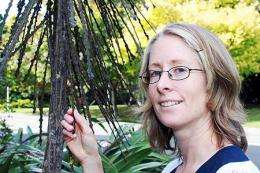Humans not always to blame for rarity

(ĚÇĐÄĘÓƵOrg.com) -- New research shows people may not be responsible for the rarity of a native tree species – a finding that could change how conservation is approached.
Institute of Fundamental Sciences research fellow Dr. Lara Shepherd worked with Leon Perrie, a botany curator at Te Papa, on a study of the threatened fierce lancewood (Pseudopanax ferox).
This small tree, known as horoeka by Maori, is found from Northland to Southland but in many locations it is very uncommon – only three plants are known between Wellington and Auckland.
Dr. Shepherd says her study found the scattered populations of lancewood across New Zealand were genetically very different from each other. “Unexpectedly, even populations with very few individuals had significant levels of genetic variation,” Dr. Shepherd says. “This indicates that the isolated populations that we see today are remnants from a time when fierce lancewood was much more widespread. It is likely that its decline is at least in part natural, beginning before humans arrived.”
She says that during the past two million years the Earth has undergone numerous climatic changes, cycling between warm interglacial periods of time, like the one we are experiencing at present, and much colder glacials.
“During glacials many plants are thought to contract into refugia – small areas where conditions are less harsh, and they are able to survive until the next interglacial when conditions again become more favourable,” she says. “However, it appears that the present late-interglacial climate conditions are not optimal for fierce lancewood, despite it being a lowland tree, and that it actually expands its distribution during other periods.”
The study has implications for conservation, she says. “At present some populations of threatened plants may be ignored if other populations are considered safe. However, this study indicates that even small populations may be worth conserving, because they may be genetically distinct.”
The results also reinforce the desirability of eco-sourcing – using locally sourced seeds in restoration efforts – so as to preserve existing genetic patterns.
The research was funded by the Royal Society of New Zealand’s Marsden Fund and the Wellington Botanical Society’s Jubilee Award and was published in the Molecular Ecology journal.
Provided by Massey University



















